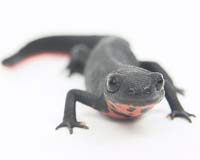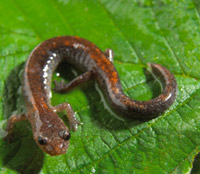
Switching from swimming to walking, walking to swimming: Some species are aquatic throughout life, some take to the water intermittently, and some are entirely terrestrial as adults. Their ability to switch between swimming and walking makes them interesting animals to study the evolution of locomotion during vertebrate evolution. The two types of gaits have been studied using neuromechanical simulations. They are capable of regenerating lost limbs.

 The female members of the suborder Salamandroidea have cloacal glands in their cloacal chamber called spermathecae used to store sperm, as well as cloacal lips to pick up the male spermatophores. The female members of the suborder Salamandroidea have cloacal glands in their cloacal chamber called spermathecae used to store sperm, as well as cloacal lips to pick up the male spermatophores.
The suborders Cryptobranchoidea and Sirenoidea have external fertilization.

The rigors of terrestrial life: Some salamanders retain their juvenile, gilled morphology but become sexually mature in a process called neoteny. The Axolotl, Ambystoma mexicanum, is a textbook example of a neotenic salamander, although there are many more neotenic species within the Ambystoma species complex. The juvenile form is retained to avoid the rigors of terrestrial life.
 Most tiny, some huge: Species of salamanders are numerous and found in most moist or aqueous habitats in the northern hemisphere. Most are small but some reach up to 5 feet in length. They live in brooks and ponds and other moist locations. North America has the hellbender and the mudpuppy which can reach the length of a foot or more. In Japan and China the giant salamander is found, which reaches 5 feet (1.5m) and weighs up to 30 kilograms]. Most tiny, some huge: Species of salamanders are numerous and found in most moist or aqueous habitats in the northern hemisphere. Most are small but some reach up to 5 feet in length. They live in brooks and ponds and other moist locations. North America has the hellbender and the mudpuppy which can reach the length of a foot or more. In Japan and China the giant salamander is found, which reaches 5 feet (1.5m) and weighs up to 30 kilograms].
Hanging in the Northern Hemisphere: Salamander habitat is generally restricted to mostly the northern hemisphere, with the exception of a few species living in the northernmost part of South America. Although common on the European mainland, salamanders are not a native species of either Great Britain or Ireland.
All text is available under the terms
of the GNU Free Documentation License
|